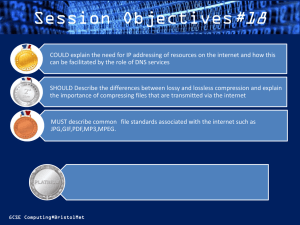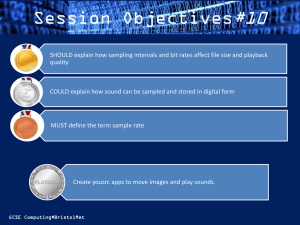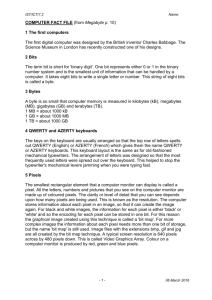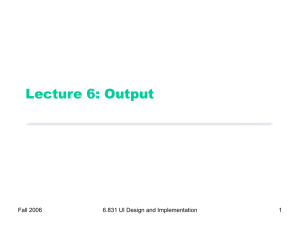GCSEComputing_Session9
advertisement
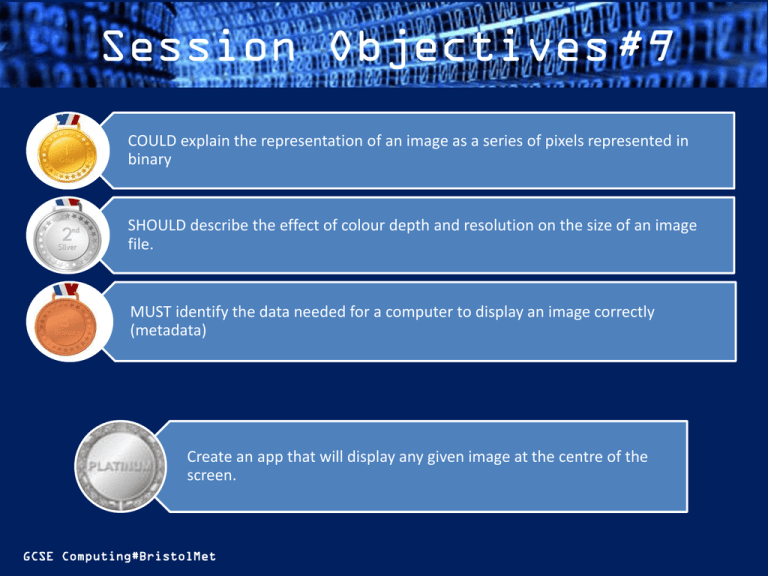
Session Objectives#9 COULD explain the representation of an image as a series of pixels represented in binary SHOULD describe the effect of colour depth and resolution on the size of an image file. MUST identify the data needed for a computer to display an image correctly (metadata) Create an app that will display any given image at the centre of the screen. GCSE Computing#BristolMet Starter Login to codecademy and work through Javascript tutorials. Those with feedback are to answer questions set. GCSE Computing#BristolMet Representing Data: Images What are the differences between these 2 images: This is called a bitmap image which is made of a number of coloured dots called pixels GCSE Computing#BristolMet This is a vector graphic which has program of a instructions to draw the image therefore keeping its proportions. Representing Data: Images Images are stored in computers as binary data. The data is interpreted by the processor and displayed according to the data it is given. Bitmap images consist of a number of boxes of colour, called pixels (picture elements). Pixel – The smallest element of an image. The dots make the image on screen. The dimensions of the image above are 8 x 5 pixels. If this is a 1 bit image (1 bit per pixel or 1bpp) it would have 2 values per pixel, 0 for white and 1 for black. TASK: Draw the image from the following binary data: 00000100 00000110 11111100 01001000 01001000. EXT: Give 2 technical explanations of how this picture could be improved? GCSE Computing#BristolMet Representing Data: Images The above image contains 40 pixels. If this was stored in an 8 bit file then it would account for 5 bytes of data (8 x 5) / 8 = 5 bytes TASK 2: If each pixel was expanded to hold 2 bits, then 2 shades of grey could be used i.e 00 is white, 01 is light grey, 10 is dark grey and 11 is black. a) How large would the image file size be now? GCSE Computing#BristolMet Representing Data: Images b) A good quality monochrome picture would use 8 bits to represent each pixel (8 bpp or one byte), therefore 256 different shades can be achieved. How large would the file size now be? Show your working. c) If the picture was in colour, each pixel would need a red, green and blue value, so each pixel would need a minimum of 3 bytes. What would the minimum memory requirement be for storing the file in colour? Show your working d) If the resolution of the image was increased (the number of pixels used to create the image) to a size of 1600 x 1000, and keeping the same colour depth, what would the minimum file size now be? GCSE Computing#BristolMet Recap Key Terms: Resolution: The concentration of pixels used to create an image (usually measured in dots or pixels per inch, dpi or ppi) Colour depth (or bit depth): The number of bits used for each pixel or dot. The more bits the more colours that can be represented. Metadata: Information about the image which the computer needs to recreate the image correctly from a binary data file. Must contain height and width in pixels, and colour depth in bpp (bits per pixel) Height & Width in pixels (8 x 5) GCSE Computing#BristolMet Colour depth: bits per pixel, bpp (2 bpp)



